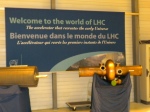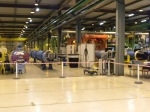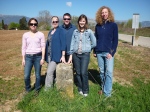CERN and The Large Hadron Collider
David Here: When humans passionately seek to understand the world we live in and how it came to be, the possibilities of what can be discovered are infinite. A perfect example of my statement would be the Large Hadron Collider (LHC) located at CERN: European Organization for Nuclear Research in Geneva, Switzerland. Even though the organization’s official paperwork and website (http://public.web.cern.ch/public/) list this address, our team can attest that many of the operations also take place just beyond the Swiss border in France.
Last Friday, our team had a unique opportunity to tour CERN. For a few of us, this was our first excursion into Switzerland and it was certainly a memorable one.
The research and advancements made at this extraordinary facility can be quite overwhelming for a person who is not fluent in physics. However, thanks to our wonderful tour guide who spoke very proper English, we were all able to learn a lot more about particles than we ever thought possible.
The LHC has a circumference of 27km (~16.5 mi) and circles areas of Switzerland and France. The giant scientific instrument is located 100m (300 ft) below ground and visitors to CERN are no longer permitted to go underground to see this mysterious wonder due to the nature of the experiments currently being facilitated. The LHC has made significant advancements in recreating the atmosphere directly after the “Big Bang,” but the organization has yet to create another universe, or at least that is what they tell us – dun dun dun.
An interesting fact many people may not be aware of back in the United States is that in 1988, while under the leadership of President George H.W. Bush, a project was approved for a Super Conducting Super Collider to be built in Texas that would have more than tripled the size of the LHC located underneath CERN. Everything is bigger in the United States, right? The Collider planned to have a circumference of 87km (54 mi). Due to budget concerns, the project was cancelled in 1993 by President Bill Clinton, so all focus and resources since then have shifted to CERN. If you would like to read more, and you are not one of my previous professors in college, I encourage you to visit Wikipedia (http://en.wikipedia.org/wiki/Superconducting_Super_Collider).
Despite being assured that all operations at the facility and under the facility are completely safe, our team is hoping another “Big Bang” will not be discovered until we return home. Nobody wants to be caught in the middle of another universe.
- LHC
- Our tour guide explaining the world of particles to our team.
- A look inside the operations at CERN
























































